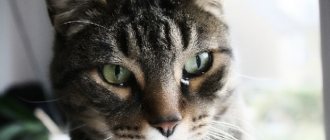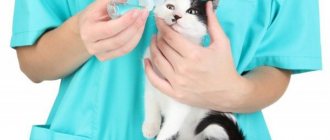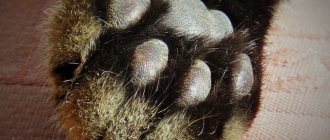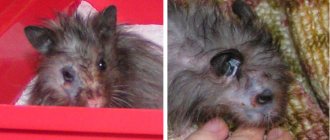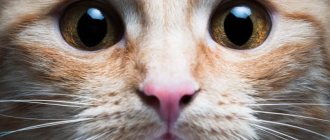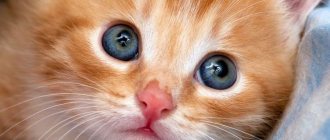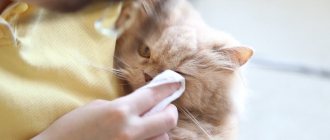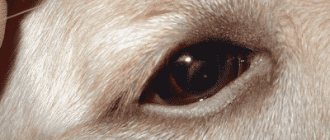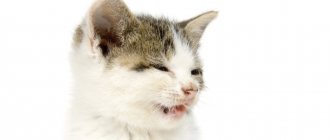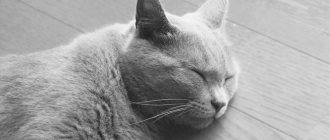The history of cat domestication goes back more than 4 thousand years, and according to one version - about 9 thousand! Despite such a long relationship, cats, largely due to their independent nature, remain mysterious creatures in the eyes of humans. Their actions cannot always be explained rationally, and their abilities have not been studied to this day. For example, what do we know about cat vision?
Color or black and white world
For quite a long time it was believed that the “mustachioed-striped” see the world around them in black and white. Studies were conducted that confirmed this fact.
However, scientists, as often happens to them, were wrong. It turned out that cats distinguish colors, although not all:
- see: gray, blue, green and their shades,
- do not see: red, brown and orange,
- They are also available in white, black and shades of gray.
But why is the whole spectrum of colors not available to them, why don’t cats see surrounding objects the same way as we do? It's all about the structure of the eye.
Warning signs
A caring owner should be alert to the following symptoms:
- Any discharge from the eyes - white, yellow or dark;
- Tears. A small amount of tears is considered normal only for flat-faced cats;
- Red or whitened mucous membrane of the eyelid;
- Visible third eyelid, that is, the mucous film on the eye that has protruded;
- Cloudiness of the eyes and changes in the color of the whites;
- Hard crusts in the corners of the eyes;
- The cat scratches or squints its eyes;
- The pet's eye does not open at all.
Some symptoms indicate the cat's general poor health. For example, if a pet’s third eyelid has protruded, it is suffering: most likely, the cat is injured or has acquired parasites.
If any of the listed signs appear, you need to urgently show the cat to the veterinarian: the slightest delay can cause the loss of an eye.
The structure of the organs of vision
Everyone knows that a cat is one of the few warm-blooded creatures that have a vertical pupil that dilates in the dark.
But the general structure of the eyes of these animals is not too different from the structure of the human eye:
We also recommend reading:
Pet habits: what signals should you pay attention to? Top 7 Dogs That Are Great for Children Stubborn Personality: Dogs That Are Difficult to Train Ways to Correct Malocclusion in Puppies
- The eyes are located in the front (a feature of predators and humans), vision is binocular or stereoscopic vision, which allows you to see objects with both eyes at once, in volume and estimate the distance to them.
- The eyeball consists of three layers: the sclera, the vascular layer and the retina.
- Fluid fills the eyeball.
- The nerves are “connected” to the back of the eye and connect it to the brain.
However, there are also differences:
- The cornea, the top layer of the sclera, occupies a much larger area and is more convex than the human cornea. That is why a cat’s viewing angle is as much as 200 degrees (for a human it is 180).
- A cat's eye has a tapetum, the very back layer of the retina that reflects light. Therefore, the eyes of these creatures “glow” in the dark. In fact, they simply reflect external light.
- Cats also have more special “devices” of rods responsible for light sensitivity than humans and many other mammals. Thanks to this, cats see us much better in the dark.
- Felines lack the “blind spot” to which nerve endings are attached in humans. These pets have a special disc and special “flasks” in this place, which also improve light sensitivity.
From what was written above, it is easy to conclude that cats see much better than people. Is it really?
How do cats' eyes work?
A cat's eyes consist of 3 main layers: the outer fibrous layer, which we see from the outside, the middle vascular layer, and the inner layer, where nerve cells are accumulated. Each of the shells has its own unique functional purpose. Let us consider in detail the mechanism of operation of each layer of tissue and the internal vision system.
Fibrous layer
This is the uppermost shell layer, enriched with collagen and elastin protein fibers. A plexus of fibers forms the sclera, a dense but elastic membrane lining the back wall of the eye. The front, visible part is the cornea. It is transparent and through it the cat’s organ of vision receives light, transmitting it to the processing of the next part of the shell.
Vascular layer
Microscopic capillaries and vessels that nourish the eye, supplying it with oxygen and necessary elements are collected here. The choroid is located between the retina (inner layer) and the sclera .
Here is the ciliary (ciliary) body, which is responsible for the position of the lens (the transparent component of the eyes of any living organism) and accommodation (the ability to clearly see objects located at different distances from oneself).
© shutterstock
In front of the ciliary body is the iris, which divides it into two chambers: external and internal. What is in the outer chamber is visible from the outside if you look at it with the eye. In the center of the iris is the pupil, which changes its size depending on the degree of illumination. The structure of the pupil has an interesting elliptical shape when constricted. A cat's eyes transform light in the same way as human vision.
How well and how far do cats see?
Surprisingly, these beautiful predators are myopic! They see objects best at a distance of no more than 6 meters. The clarity of vision of cats extends to a distance of about 20 meters, then a blurred spot.
This seems strange, because they are predators and successful hunting and the survival of the species depend on vision.
However, cats, unlike ancient people and large predators, hunt small prey, usually hiding not far from the ground. They simply don't need to look too far ahead!
Cat vision parameters
Cats are farsighted pets who see well at a distance and have difficulty distinguishing nearby objects. Below we describe what kind of vision cats have and its features.
Range
The main focus of the cat's gaze occurs at a distance of 2-6 m from them. It is at this distance that she can absolutely accurately assess the location of an object and see details.
Due to this feature, her jump from ambush onto prey is accurate and fast.
When preparing to attack an object, the animal nods its head slightly, thereby focusing on the prey and increasing the accuracy of the attack. If the distance from the cat to the object exceeds 20 m, the pet’s vision is blurry. He also does not distinguish the details of objects located at a distance of 50 cm from him. Instead of vision, the cat uses touch and smell.
Sector of review
Many owners notice that when playing, the cat shakes its head up and down. So she prepares to attack the victim or jump. This means that the animal’s viewing angle changes and it more accurately calculates the distance to its prey. The vision mechanism allows the predator to almost always capture its prey.
For good visual acuity, it is important not only what colors animals distinguish, but also how clearly they see certain small details. The ability to examine them is especially developed at night; it increases 6-7 times. But during the day, cats see worse than humans. This gap is filled by better peripheral vision. A dozing pet can view the environment 220-240°, while ours can view the environment up to 180°.
READ Milbemax for kittens - tablets for kittens, composition, use, dosage
Volume
Many people are interested in how cats see. They recognize surrounding objects as three-dimensional, they have binocular vision. This means that both eyes can notice the same object, the image of which enters the brain, is processed by it and converted into a three-dimensional image.
Some researchers estimate that the number of frames per second is 40, but a person sees only 24. Modern television is designed precisely for this speed of perception. The pet only sees changing pictures on the TV screen. For cats to notice moving frames, you will need a speed of 50 frames/sec. Animals perceive moving objects much faster than humans.
For your information! The cat distinguishes objects moving in a horizontal plane very well, but in a vertical position it is a little slower.
How are things going with frame 25?
Almost everyone knows that the speed of human frame perception is 24 frames per second. This is precisely what the notorious 25th frame effect is based on, which a person no longer perceives, but, as it were, “records” into the subconscious.
If someone wanted to “zombify” cats, they would have to include not the 25th, but the 41st or even the 51st frame in the films, because this is precisely the speed of perception of our pets.
A fast-flying fly (in human understanding) does not move so fast for cats: a precise blow with its paw is enough to knock it down.
Causes
Most ophthalmological problems in pets develop due to the fault of their owners. Ignorance about the rules of correct keeping, feeding, caring for your pet, inattention, careless or even disregard for your pet ends sadly. Here are some man-made factors that cause ophthalmic problems in cats:
- unbalanced, poor nutrition;
- unsatisfactory sanitary living conditions;
- physical punishment, blows to the head, muzzle, nose area;
- an attempt to wean him from peeing past the tray by poking his muzzle into a puddle;
- excessive, insufficient or incorrect implementation of hygiene procedures on the organs of vision;
- eye and head injuries caused by falling out of a window, inadequate arrangement of furniture (for example, furniture is positioned in such a way that if an animal falls from a cabinet there is a risk of hitting the deck of a coffee table, the corner of a cabinet), as well as the lack of restraining devices (eg anti-cat mesh) or safety precautions ;
- non-interference or indulgence in fights between the cat and other animals, bullying;
- refusal of routine examinations by a doctor, neglect of consultations with a veterinarian, attempts at self-medication;
- insufficient attention to the needs, condition, safety of the cat;
- an environment in which the animal experiences prolonged severe stress;
- other unfavorable conditions created by man;
And which of us is the beast???
On the other hand, there are a number of factors beyond the control of the owner that can cause problems. For example:
- age-related changes and concomitant diseases (lens opacification, retinal dystrophy, optic nerve pathology);
- congenital defect of connective tissues (this type of tissue is the basis of all structures of the body, nervous, muscle, bone; a congenital defect, also called dysplasia, negatively affects the condition of all body systems; unfortunately, dysplasia cannot be treated, only supportive therapy is possible);
- hereditary tendency of certain breeds to problems of an ophthalmological nature (lacrimation, retinal atrophy, inflammation of the conjunctiva, etc.);
- poor heredity, as a result of which multiple ailments develop;
The good news is that all the items on both lists can be eliminated. It is enough to study the basics of correct keeping of mursaks in the house, consciously approach the choice of a pet, and take a responsible approach to the safety, living conditions and health of the animal. Agree: following them is much easier than wasting your nerves, time, and money on treating your rumbling friend.
We are responsible for those we have tamed
Cat eye care
To keep your pet's eyes healthy and pain-free, they need to be properly cared for. Examine your cat regularly and watch out for unwanted symptoms.
Cats with a flat face need to regularly wipe their eyes with a special solution. The same medicine will come in handy if your cat has an eye infection.
The solution can also be replaced with cold strong tea or herbal decoction, but this is not suitable for light-colored pets. The liquid is applied to a cotton pad, and then wiped from the outer corner to the inner one.
If your cat has disturbing and irritating hairs growing around his eyes, it is better to cut them off quietly. Be careful and secure the cat well during this procedure.
